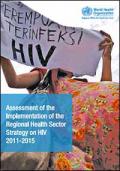Publications - Released in 2016
The World Health Organization (WHO) South-East Asia Region is home to a quarter of the world’s population and includes two of the world’s most populous countries: India and Indonesia. The 11 countries that comprise the Region have huge social, economic and physical differences, which account for the wide variations in the HIV epidemics across the Region. The epidemic and the health sector response varies widely among and within Member States. Over 99% of people living with HIV (PLHIV) are in five countries: India, Indonesia, Myanmar, Nepal and Thailand.
The WHO Regional Health Sector Strategy on HIV, 2011–2015 was developed with the overarching aim of assisting Member States to achieve universal access to prevention, diagnosis, treatment and care, which would contribute to the achievement of Millennium Development Goal (MDG) 6 and other health-related goals. The Strategy described the future directions and focus of work for HIV programmes and WHO in the health sector response to the HIV epidemic.
Downloads
Organizations
- World Health Organization (WHO)






